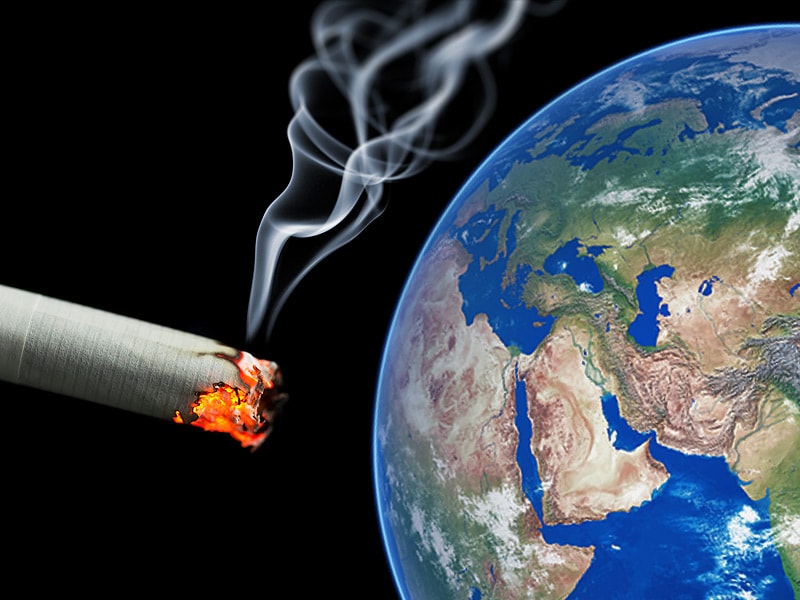Share your quitting journey
- EX Community
- Conversations
- Journals / Blogs
- Cigarettes and Planet Earth
Cigarettes and Planet Earth
- Subscribe to RSS Feed
- Mark as New
- Mark as Read
- Bookmark
- Subscribe
- Printer Friendly Page
- Report Inappropriate Content

 We Addicts ignore our values if they conflict with our drug use. As Nicotine Addicts we can erroneously be tree hugging environmentalists while using a highly toxic and wasteful product. The following articles site just some of the ways that cigarettes destroy and pollute our one and only Planet Earth:
We Addicts ignore our values if they conflict with our drug use. As Nicotine Addicts we can erroneously be tree hugging environmentalists while using a highly toxic and wasteful product. The following articles site just some of the ways that cigarettes destroy and pollute our one and only Planet Earth:
Fewer cigarette butts means a less toxic environment.
While most people know that exposure to tobacco smoke—both active and passive—is life-threatening, many do not realize that the dangers from smoking don’t end once a cigarette is extinguished. A growing body of research is documenting the impact of tobacco litter on the environment. In the US alone, a large number of the 280 billion cigarettes purchased each year end up littering sidewalks, waterways, parks, beaches and public roads.
But the environmental impact of tobacco goes far beyond litter. Cigarette butts leach toxic chemicals —including arsenic, cadmium, lead and polycyclic aromatic hydrocarbons—that could pollute the environment and harm its ecosystems. They are mostly made of plastic and are only biodegradable under ideal conditions, making them a long-lasting threat to the environment.
And like many aspects of tobacco, the impact of cigarettes on the environment has economic implications as well. Cities, towns and other municipalities must pay clean-up costs for tobacco litter; in 2009, in the city of San Francisco alone, these costs were estimated to be more than $10 million each year.
http://www.legacyforhealth.org/our-issues/cigarettes-and-the-environment
Worldwide, it is estimated that 1.69 billion pounds of cigarette butts end up as waste each year. 910 A study conducted by the California Department of Transportation found that cigarette butts make up 34 percent of the total waste captured in California.11
The production of cigarettes is very damaging to the environment. It is estimated that one tree is consumed for every 300 cigarettes produced - that's one tree for every one and a half cartons.12
Smoking poses a direct threat to our forests, homes and parks.12 Discarded cigarette butts have been linked to large wildfires, resulting in the destruction of wildlife, vegetation and property.14 Cigarette-induced fires claim hundreds of lives in California each year, not to mention the millions of dollars in property damage.
http://www.tobaccofreeca.com/smoking-problem/impact/environment/
There are around 1.2 billion smokers in the world (about one-third of the global population aged 15 and over). Nearly forty per cent (39.4%) of Europeans smoke, (up from 1995, when a figure of 33.9% recorded.)
At least 4.5 trillion [non-biodegradable] filter-tipped cigarettes are deposited annually somewhere in the world.
China, United States, Brazil, Turkey and Indonesia are the five countries that produce the most raw tobacco leaves and manufactured cigarettes.
Malawi, Korea, Macedonia, Moldova, and Lebanon devote more than 1% of their agricultural land to tobacco leaf production.
In Africa, around 5% of all deforestation is caused by tobacco. In Malawi, where the ancient dry forests of the miombo highlands are particularly under threat, tobacco accounts for 20% of deforestation.
Each year nearly 600 million trees are destroyed to provide fuel to dry tobacco. Put in another way one tree is destroyed for every 300 cigarettes.
Globally, tobacco curing requires 11.4 million tons of solid wood annually.
Tobacco is a sensitive plant prone to many diseases. It therefore requires huge chemical inputs: up to 16 applications of pesticide are recommended during one three-month growing period. Aldrin and Dieldrin, and DDT are among the chemicals used. Methyl bromide, widely used as a fumigant in developing countries, contributes significantly to ozone depletion.
As well as being hazardous to users, chemicals may run off into water courses, contaminating local water supplies.2 There are also concerns about high levels of pesticide use leading to the development of resistance in mosquitoes and flies, making the control of diseases such as malaria more difficult.
Tobacco is particularly potassium-hungry, absorbing up to six times as much as other crops, leaving soil in poor condition for essential food and cash crops.
Modern cigarette manufacturing machines use more than six kilometres of paper per hour.
In 1995 worldwide tobacco manufacturing produced 2.26 billion kilograms of solid waste and 209 million kilograms of chemical waste.
Releases to the environment of Toxics Release Inventory chemicals by the tobacco manufacturing industry in the United States recorded for 1996 included (but weren't limited to):
Ammonia 946,155 kg
Hydrochloric acid 407,371 kg
Methyl ethyl ketone 340,821 kg
Nicotine and nicotine salts 900,377 kg
Sulphuric acid 67,228 kg
Toluene 349,622 kg
http://www.treehugger.com/green-food/smoking-environmental-and-social-impacts.html
Need I say more?
When we quit smoking we can return to our authentic selves and live by our Values!
You must be a registered user to add a comment. If you've already registered, sign in. Otherwise, register and sign in.
-
Helping Adult Quit
13 -
Helping Child Quit
11 -
Longtime Quit
879 -
Preparing to Quit
275 -
Quitting Chewing
17 -
Quitting Medicinal Nicotine
15 -
Quitting Smoking
363 -
Quitting Tobaccoless Pouches
10 -
Quitting Vaping
174 -
Recently Quit
431 -
Staying Quit
173 -
Trying Again
172 -
Undecided
19






